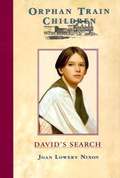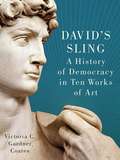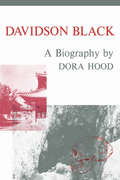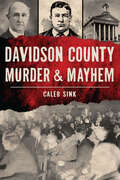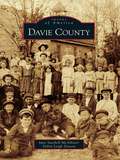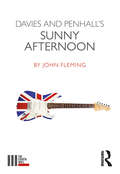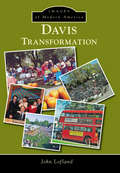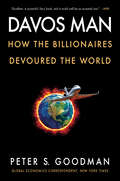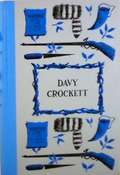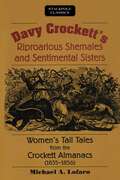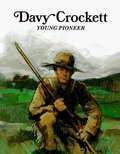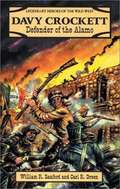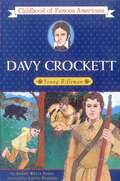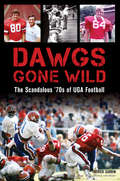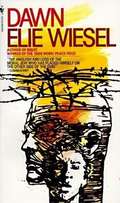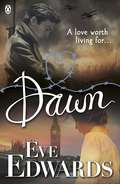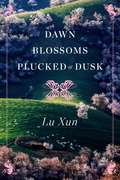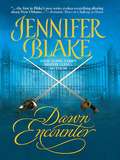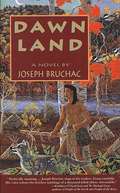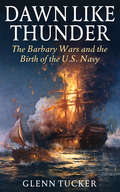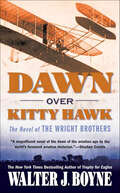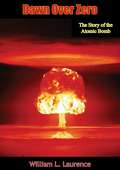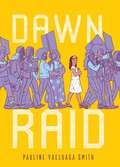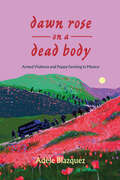- Table View
- List View
David's Search (The Orphan Train Children #4)
by Joan Lowery NixonHistory comes alive in this entertaining and educational series for readers ages 7-11, written by the author of the Orphan Train Adventures. David Howard has been living on the streets of New York City so long he can barely remember his parents.
David's Sling
by Ph.D. Victoria C. CoatesThroughout Western history, the societies that have made the greatest contributions to the spread of freedom have created iconic works of art to celebrate their achievements. Yet despite the enduring appeal of these works-from the Parthenon to Michelangelo's David to Picasso's Guernica-histories of both art and democracy have ignored this phenomenon. Millions have admired the artworks covered in this book but relatively few know why they were commissioned, what was happening in the culture that produced them, or what they were meant to achieve. Even scholars who have studied them for decades often miss the big picture by viewing them in isolation from a larger story of human striving.David's Sling places into context ten canonical works of art executed to commemorate the successes of free societies that exerted political and economic influence far beyond what might have been expected of them. Fusing political and art history with a judicious dose of creative reconstruction, Victoria Coates has crafted a lively narrative around each artistic object and the free system that inspired it.This book integrates the themes of creative excellence and political freedom to bring a fresh, new perspective to both. In telling the stories of ten masterpieces, David's Sling invites reflection on the synergy between liberty and human achievement.
Davidson Black: A Biography
by Dora HoodIn 1929 a fossilized skull found in Peking was named Sinanthropus pekinensis, Peking Man. Dr. Davidson Black, a Canadian anatomist and anthropologist, was responsible for finding and identifying this important clue to the nature of the ancestors and development of modern Man. Although he won world renown for this discovery, until now little has been written about the distinguished scientist. In this, the first full account of his life, Mrs. Hood describes Dr. Black's education—at the Toronto Model School, where he was one of the many pupils who distinguished himself in later life; at Harbord Collegiate in Toronto; and at the School of Medicine of the University of Toronto where he first began to show a marked interest in the study of anatomy. She follows his career then to a teaching position at Western Reserve University, and through the usual sequence of opportunities that eventually led him to China. It was while Dr. Black was on the staff of the Peking Union Medical College that he was able to pursue his interest in a promising area of human prehistory, and these investigations culminated in the discovery of Peking Man. Mrs. Hood has succeeded in bringing together with care and perception the story of Dr. Black and his work, which was scattered in many places, and does so with an ease and simplicity of expression which will attract readers. The fascination of Davidson Black's devotion to the exploration of the mysteries of human pre-history has been well rendered.
Davidson County Murder & Mayhem (Murder & Mayhem)
by Caleb SinkExplore the dark side of Davidson County's past. After killing his brother-in-law in 1904, wealthy businessman Henry Clay Grubb of the Churchland community was himself killed in 1913. In 1918 an adulterous affair led Graham Hege to kill his best friend, Frank Deaderick. Though most perpetrators were caught, if not convicted, the identity of the murderer of Sarah Holland Springs remains a mystery to this day. These twelve stories explore the shadowy side of this portion of the Piedmont. Join author Caleb Sink, a lifelong resident of Davidson County, on his quest to uncover two centuries of secrets.
Davie County (Images of America)
by Jane S. Mcallister Debra DotsonDavie County, carved out of Rowan County and named for a Revolutionary War hero in 1836, boasts a rich history. The Great Wagon Road brought many settlers to the area in the 18th century, including Daniel Boone's parents--buried in Joppa Cemetery in Mocksville. The National Historical Register includes 16 county sites, among them the Cooleemee Plantation, home to the Hairston family since 1817. Davie County's agricultural heritage is complemented by its progressing commercial and retail development. Images of America: Davie County commemorates the area's communities, people, livelihoods, pastimes, and traditions, including the annual Masonic Picnic, observed for over 130 years.
Davies and Penhall's Sunny Afternoon
by John FlemingWhen ‘You Really Got Me’ exploded on Swinging London in 1964, the Kinks forever changed the course of rock ’n’ roll. Ray Davies and Joe Penhall’s Olivier Award-winning Sunny Afternoon (2014) covers the band’s formative years of 1964–7, when four working- class North London lads broke through to become one of the most unlikely and influential rock bands of the 1960s. Mixing the comic adventures of ‘Dave the Rave’ with the touching introspection of Ray’s sometimes fragile psyche, Joe Penhall’s script weaves Ray Davies’ songs, both the hits and lesser-known works, into one of the finest jukebox musicals of the new millennium. Drawing on a wealth of background material, John Fleming examines the blend of events and songs selected, reconsidering the relationship between biography and drama to shed new light on the Kinks and the musical that tells their story.
Davis: Transformation (Images of Modern America)
by John LoflandDavis has undergone a major transformation from the mid-20th century to today, growing from a small college town of about 3,000 residents and 1,500 students to a world-class university city of 80,000 area residents and 35,000 students. Major features of this revolution include the creation of a vibrant downtown, environmentally sensitive politics, diverse and innovative neighborhoods, and a citywide system of bike lanes. A thriving University of California at Davis campus was the economic dynamo that attracted talented students and faculty. Their environmentalist values spurred innovations in solar energy, waste recycling, bicycle infrastructure, subsidized public transit, energy-saving construction, and farm-to-fork localization of food supplies, among other new civic directions that remain an essential part of the city's culture today.
Davos Man: How the Billionaires Devoured the World
by Peter S. GoodmanFrom the New York Times’s Global Economics Correspondent, a masterwork of explanatory journalism that exposes how billionaires’ systematic plunder of the world—brazenly accelerated during the pandemic—has transformed 21st-century life and dangerously destabilized democracy. "Davos Man will be read a hundred years from now as a warning. ... Deliciously rich with searing detail, the clarity is reminiscent of Tom Wolfe." —EVAN OSNOSThe history of the last half century in America, Europe, and other major economies is in large part the story of wealth flowing upward. The most affluent people emerged from capitalism's triumph in the Cold War to loot the peace, depriving governments of the resources needed to serve their people, and leaving them tragically unprepared for the worst pandemic in a century.Drawing on decades of experience covering the global economy, award-winning journalist Peter S. Goodman profiles five representative "Davos Men"–members of the billionaire class–chronicling how their shocking exploitation of the global pandemic has hastened a fifty-year trend of wealth centralization. Alongside this reporting, Goodman delivers textured portraits of those caught in Davos Man’s wake, including a former steelworker in the American Midwest, a Bangladeshi migrant in Qatar, a Seattle doctor on the front lines of the fight against COVID, blue-collar workers in the tenements of Buenos Aires, an African immigrant in Sweden, a textile manufacturer in Italy, an Amazon warehouse employee in New York City, and more.Goodman’s rollicking and revelatory exposé of the global billionaire class reveals their hidden impact on nearly every aspect of modern society: widening wealth inequality, the rise of anti-democratic nationalism, the shrinking opportunity to earn a livable wage, the vulnerabilities of our health-care systems, access to affordable housing, unequal taxation, and even the quality of the shirt on your back. Meticulously reported yet compulsively readable, Davos Man is an essential read for anyone concerned about economic justice, the capacity of societies to grapple with their greatest challenges, and the sanctity of representative government.
Davy Crockett
by Anne FordThis book describes the life and accomplishments of David Crockett who became famous for his ability as hunter, woodsman, politician, and soldier.
Davy Crockett
by Constance RourkeBlending myth and reality, Constance Rourke aimed to get at the heart of Davy Crockett, whose hold on the American imagination was firm even before he died at the Alamo. Davy Crockett, published in 1934, pioneered in showing the backwoodsman’s transformation into a folk hero. It remains a basic in the Crockett literature.<P><P> A Newbery Honor Book.
Davy Crockett's Riproarious Shemales and Sentimental Sisters (Stackpole Classics)
by Michael LofaroThe legendary feats of Davy Crockett, who could tree a ghost, ride his thirty-seven-foot-long alligator up Niagara Falls, and drink up the Mississippi River, are common knowledge to devotees of this nineteenth-century comic superhero. But what may come as a surprise to many is that the legendary frontiersman also served as the fictional narrator of a collection of outrageous tall tales about women in the same Crocket Almanacs in which he &“recorded&” his own adventures. Conceived as a marketing device by nineteenth-century publishers hoping to gain a share of the lucrative almanac market, such stories made these slim volumes the best-selling and longest-running series of comic almanacs published in the United States before the Civil War. Booking back at them now, the Crocket Almanacs offer a true &“fun house mirror&” view of the culture of antebellum America.
Davy Crockett, Young Pioneer
by Laurence SantreyA story about the life of Davy Crockett, a young American pioneer.
Davy Crockett: Defender of the Alamo (Legendary Heroes of the Wild West)
by Carl R. Green William R. SanfordRelates the true story of Davy Crockett, one of the Old West's outstanding hunters, frontiersmen, and legislators.
Davy Crockett: Young Rifleman (Childhood of Famous Americans)
by Aileen Wells ParksA biography of the famous frontiersman and Congressman, focusing on his childhood.
Dawgs Gone Wild: The Scandalous ’70s of UGA Football
by Patrick Garbin Steve Shag" DavisIn the mid-�70s, the University of Georgia football team caused quite a stir off the field. Several players had encounters with the manipulative �Godfather of Pro Wrestling� and his money-for-sex scheme. A careless prank aboard a team-chartered airplane resulted in a bomb scare and an FBI inquiry. The mysterious death of a standout teammate in 1976 remained unsolved for decades. Despite it all, a valiant and tenacious head coach and his acclaimed �Junkyard Dogs� defied the odds and developed a celebrated championship team. UGA football writer and historian Patrick Garbin, using extensive interviews with former players and coaches, delivers an astounding and, at times, appalling true tale of sex, drugs and wild debauchery in college football.
Dawn
by Elie Wiesel Frances FrenayeTwo men wait through the night in British-controlled Palestine for dawn--and for death. One is a captured English officer. The other is Elisha, a young Israeli freedom fighter whose assignment is to kill the officer in reprisal for Britain's execution of a Jewish prisoner. Elisha's past is the nightmare memory of Nazi death camps. He is the only surviving member of his family. His future is a cherished dream of life in the promised homeland. But at daybreak his present will become the tortured reality of a principled man ordered to commit cold-blooded murder. Resonant with feeling, DAWN is an unforgettable journey into the human heart--and an eloquent statement about the moral basis of the new Israel.
Dawn
by Eve EdwardsDawn is the sequel to Dusk, the epic wartime romance by Eve EdwardsLondonPaddington Station22 October 1916Sebastian reached in his pocket for the portrait of Helen he had drawn only last year. 'I'm looking for a young lady who came through here late last night.'Sebastian Trewby doesn't have long before he will be called back to the front line, and Helen has disappeared. He must find her and make her realise that he will protect her before it's too late.Helen knows that if Sebastian discovers her it could ruin him. But threatened by a society that wants to persecute her at every turn, her only hope lies with those that love her. And the authorities are closing in...[praise for DUSK] 'This is a book that is heartbreaking and romantic, a book that will tug at your heartstrings and make you think about it long after you close the last page.' Goodreads reviewer'I could say so much more in praise of this novel, but really, I think it would be better if I just said this: Read 'Dusk', I don't think you will be disappointed.' Amazon reviewer
Dawn Blossoms Plucked at Dusk (Echoes Of Classics Ser.)
by Lu XunA collection of essays by Lu Xun, one of the most influential figures of modern Chinese literature. In this classic and beautiful collection, Lu Xun recounts the stories of his childhood and youth in Shaoxing, China. A revolutionary thinker and writer, and one of the architects of the May 4th Movement, his stories reveal the beauty, joy, and struggle of life in early twentieth-century China.
Dawn Encounter
by Jennifer BlakeLisette Moisant is a widow, courtesy of the swordsmanship of Caid O'Neill, one of the city's legendary maîtres d'armes. He bested her loathsome husband in a duel, but now she is a pawn of schemers who wish to steal her fortune and see her dead. It is Caid to whom she turns for protection, and guilt leaves him no recourse but to agree to Lisette's request.But soon a whispering campaign is being waged against them, suggesting the two plotted to kill Lisette's husband all along, that she is a woman of loose morals and he is nothing short of a murderer. In a society where reputation is everything, the scandal and accusations threaten Lisette and Caid with ruin, and the person responsible will stop at nothing until they have paid with their lives.
Dawn Land: A Novel
by Joseph BruchacAn action-packed adventure story spun in authentic native oral tradition, Dawn Land unfolds about ten thousand years ago, in the area now known as New England. A shadow is crossing over the land, and the village's finest son must meet the threat.
Dawn Like Thunder: The Barbary Wars and the Birth of the U.S. Navy
by Glenn TuckerDawn like Thunder: The Barbary Wars and the Birth of the U.S. Navy, first published in 1963, is the definitive account of the fledgling Navy and Marine Corps of the United States in the early 1800s. The book details the struggle of American ships such as the USS Constitution and Constellation against the pirates and Muslim warlords of the Mediterranean and North Africa in what would become known as the Barbary Wars. Also covered are the key players of the time, from presidents Thomas Jefferson and John Adams, to talented naval officers such as Edward Preble and Stephen Decatur. In addition, the ongoing political battles to obtain funding for the Navy and the construction of needed ships are described. Author Glenn Tucker (1892-1976) conducted extensive research in the preparation of Dawn like Thunder, including research at the archives in Tripoli; he was the author of more than a dozen books on American history.
Dawn Over Kitty Hawk: The Novel of the Wright Brothers
by Walter J. BoyneThe names Wilbur and Orville Wright stand out in history as the inventors of the airplane, but lost in history are those who in the closing years of the nineteenth century and the first years of the twentieth shared the same passion: to develop the first powered aircraft. Some spent entire lives and fortunes chasing the dream, including men like the embittered Augustus Herring, who'd flown a heavier than air machine for several seconds in 1898; the pompous Samuel Pierpont Langley, of the Smithsonian Institution, who was backed by the US War Department, and even the legendary American inventor Alexander Graham Bell. These men, along with European competitors such as Louis Blériot, chased what many believed to be the impossible dream of manned, powered flight. But the Wright Brothers were the first to succeed, thanks to a combination of courage, genius, and downright stubbornness! Many followed in their footsteps, including such arch-competitors as Glenn Curtiss.The Wright Brothers' father was a huge factor who dominated their lives, trying to control their every thought and action. A bishop of the United Brethren Church, Milton Wright wanted his sons to succeed in their bicycle shop in Dayton, Ohio, not risk their lives. Bishop Wright saw no reason for his sons to risk everything on an isolated, windy beach in faraway North Carolina a beach called Kitty Hawk. He tried to quash their dream, but Orville and Wilbur rebelled, ultimately proving the impossible by flying on December 17, 1903. They brought the dawn of aviation, the industry that dominated the twentieth century and set the stage for the space race.At the Publisher's request, this title is being sold without Digital Rights Management Software (DRM) applied.
Dawn Over Zero: The Story of the Atomic Bomb
by William L. LaurenceOn August 6, 1945, the world was electrified by the news that an American Army bomber had dropped an atomic bomb, with an explosive power equivalent to 20,000 tons of TNT, on the important Japanese military center of Hiroshima. Three days later another bomb, of improved design and even greater power, was dropped on Nagasaki. The following day, Aug. 10, the Japanese sued for peace.Newspapers and magazines throughout the world printed many thousands of words about the new weapon and the scientific developments that had made it possible. These stories were based largely on official War Department releases prepared by William L. Laurence, science reporter for The New York Times. At the request of the War Department, Mr. Laurence had been granted a leave by The Times several months earlier.Mr. William L. Laurence was the only newspaper man permitted by the War Department to go to all the plants and inspect the processes of production of the atomic bomb, the only newspaper man allowed to witness the secret trial of the bomb in New Mexico, and the only newspaper man who witnessed the actual dropping of one of the bombs on Japan, from a plane above Nagasaki.This book, first published in 1946, is the full story, so far as it may yet be revealed, of the atom bomb, written by the man who is unquestionably the best qualified to write it for the layman.
Dawn Raid
by Pauline Vaeluaga SmithImagine this: You're having an amazing family holiday, one where everyone is there and all 18 of you are squeezed into one house. All of sudden it's 4 o'clock in the morning and there's banging and yelling and screaming. The police are in the house pulling people out of bed ...Sofia is like most 12-year-old girls in New Zealand. How is she going to earn enough money for those boots? WHY does she have to give that speech at school? Who is she going to be friends with this year?It comes as a surprise to Sofia and her family when her big brother, Lenny, starts talking about protests, "overstayers", and injustices against Pacific Islanders by the government. Inspired by the Black Panthers in America, a group has formed called the Polynesian Panthers, who encourage immigrant and Indigenous families across New Zealand to stand up for their rights. Soon the whole family becomes involved in the movement.Told through Sofia's diary entries, with illustrations throughout, Dawn Raid is the story of one ordinary girl living in extraordinary times, learning how to stand up and fight.
Dawn Rose on a Dead Body: Armed Violence and Poppy Farming in Mexico (California Series in Public Anthropology)
by Adèle BlazquezFeatured prominently in the Netflix series Narcos, Badiraguato is known as the birthplace of Mexico's most notorious criminals, from Caro Quintero to "El Chapo." But in this rural community in the Sinaloa sierra, what is the daily life of those invisible in the criminal fresco, who live in this jobless region, grow a tiny patch of poppies, run a grocery store, or hold a position in the local government? Who are the poppy farmers, caught between military repression and exploitation by those who buy their crops? What does it mean to be a woman in a place where men’s violence looms? How can people make sense of the killings that punctuate daily life? This sensitive ethnography lifts the veil on a marginalized territory that is the downside of our globalized economy; an ethnography that confronts us with the uncertainty that reigns when, once again, "Dawn rose on a dead body."
